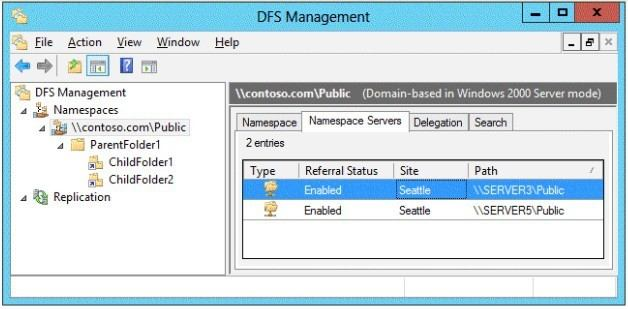Download Microsoft.70-411.Lead2Pass.2019-01-24.182q.tqb
| Vendor: | Microsoft |
| Exam Code: | 70-411 |
| Exam Name: | Administering Windows Server 2012 |
| Date: | Jan 24, 2019 |
| File Size: | 19 MB |
| Downloads: | 1 |
Demo Questions
Question 1
Your network contains an Active Directory domain named contoso.com. The domain contains a member server named Server1. Server1 runs Windows Server 2012 R2 and has the Hyper-V server role installed.
Server1 hosts 10 virtual machines. A virtual machine named VM1 runs Windows Server 2012 R2 and hosts a processor-intensive application named App1.
Users report that App1 responds more slowly than expected.
You need to monitor the processor usage on VM1 to identify whether changes must be made to the hardware settings of VM1.
Which performance object should you monitor on Server1?
- Processor
- Hyper-V Hypervisor Virtual Processor
- Hyper-V Hypervisor Logical Processor
- Hyper-V Hypervisor Root Virtual Processor
- Process
Correct answer: C
Explanation:
In the simplest way of thinking the virtual processor time is cycled across the available logical processors in a round-robin type of fashion. Thus all the processing power gets used over time, and technically nothing ever sits idle. To accurately measure the processor utilization of a guest operating system, use the "\Hyper-V Hypervisor Logical Processor (Total)\% Total Run Time" performance monitor counter on the Hyper-V host operating system. In the simplest way of thinking the virtual processor time is cycled across the available logical processors in a round-robin type of fashion. Thus all the processing power gets used over time, and technically nothing ever sits idle.
To accurately measure the processor utilization of a guest operating system, use the "\Hyper-V Hypervisor Logical Processor (Total)\% Total Run Time" performance monitor counter on the Hyper-V host operating system.
Question 2
Your network contains an Active Directory domain named contoso.com. All servers run Windows Server 2012 R2. The functional level of both the domain and the forest is Windows Server 2008 R2.
The domain contains a domain-based Distributed File System (DFS) namespace that is configured as shown in the exhibit.

You need to enable access-based enumeration on the DFS namespace.
What should you do first?
- Raise the domain functional level.
- Raise the forest functional level.
- Install the File Server Resource Manager role service on Server3 and Server5.
- Delete and recreate the namespace.
Correct answer: D
Explanation:
Access-based enumeration is only supported on a Domain-based Namespace in Windows Server 2008 Mode. This type of Namespace requires a minimum Windows Server 2003 forest functional level and a minimum Windows Server 2008 domain functional level. The exhibit indicates that the current namespace is a Domain-based Namespace in Windows Server 2000 Mode. To migrate a domain-based namespace from Windows 2000 Server mode to Windows Server 2008 mode, you must export the namespace to a file, delete the namespace, recreate it in Windows Server 2008 mode, and then import the namespace settings. Reference:http://msdn.microsoft.com/en-us/library/cc770287.aspxhttp://msdn.microsoft.com/en-us/library/cc753875.aspx Access-based enumeration is only supported on a Domain-based Namespace in Windows Server 2008 Mode. This type of Namespace requires a minimum Windows Server 2003 forest functional level and a minimum Windows Server 2008 domain functional level.
The exhibit indicates that the current namespace is a Domain-based Namespace in Windows Server 2000 Mode. To migrate a domain-based namespace from Windows 2000 Server mode to Windows Server 2008 mode, you must export the namespace to a file, delete the namespace, recreate it in Windows Server 2008 mode, and then import the namespace settings.
Reference:
http://msdn.microsoft.com/en-us/library/cc770287.aspx
http://msdn.microsoft.com/en-us/library/cc753875.aspx
Question 3
Your network contains an Active Directory domain named contoso.com. The domain contains a server named Server1 that runs Windows Server 2012 R2.
A local account named Admin1 is a member of the Administrators group on Server1.
You need to generate an audit event whenever Admin1 is denied access to a file or folder.
What should you run?
- auditpol.exe /set /user:admin1 /failure:enable
- auditpol.exe /set /user:admin1 /category:"detailed tracking" /failure:enable
- auditpol.exe /resourcesacl /set /type:file /user:admin1 /failure
- auditpol.exe /resourcesacl /set /type:key /user: admin1 /failure /access:ga
Correct answer: C
Explanation:
To set a global resource SACL to audit successful and failed attempts by a user to perform generic read and write functions on files or folders:auditpol /resourceSACL /set /type: File /user:MYDOMAINmyuser /success /failure /access: FRFWSyntax auditpol /resourceSACL [/set /type: <resource> [/success] [/failure] /user: <user> [/access: <access flags>]][/remove/type: <resource>/user: <user> [/type: <resource>]][/clear [/type: <resource>]][/view [/user: <user>] [/type: <resource>]]References:http://technet.microsoft.com/en-us/library/ff625687(v=ws.10).aspxhttp://technet.microsoft.com/en-us/library/ff625687.aspx To set a global resource SACL to audit successful and failed attempts by a user to perform generic read and write functions on files or folders:
auditpol /resourceSACL /set /type: File /user:MYDOMAINmyuser /success /failure /access: FRFW
Syntax
auditpol /resourceSACL
[/set /type: <resource> [/success] [/failure] /user: <user> [/access: <access flags>]]
[/remove/type: <resource>/user: <user> [/type: <resource>]]
[/clear [/type: <resource>]]
[/view [/user: <user>] [/type: <resource>]]
References:
http://technet.microsoft.com/en-us/library/ff625687(v=ws.10).aspx
http://technet.microsoft.com/en-us/library/ff625687.aspx






